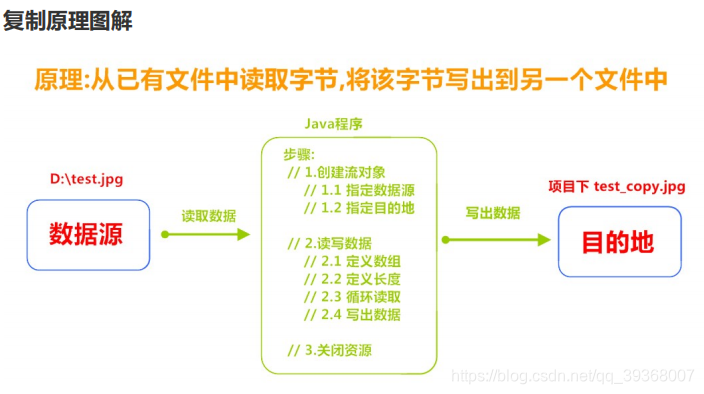字节流练习:图片复制
本文共 1311 字,大约阅读时间需要 4 分钟。


文件复制练习:一读一写
明确:
数据源: c:\\1.jpg 数据的目的地: d:\\1.jpg文件复制的步骤:
1.创建一个字节输入流对象,构造方法中绑定要读取的数据源 2.创建一个字节输出流对象,构造方法中绑定要写入的目的地 3.使用字节输入流对象中的方法read读取文件 4.使用字节输出流中的方法write,把读取到的字节写入到目的地的文件中 5.释放资源package com.itheima.demo03.CopyFile;import java.io.FileInputStream;import java.io.FileOutputStream;import java.io.IOException;public class Demo01CopyFile { public static void main(String[] args) throws IOException { long s = System.currentTimeMillis(); //1.创建一个字节输入流对象,构造方法中绑定要读取的数据源 FileInputStream fis = new FileInputStream("c:\\1.jpg"); //2.创建一个字节输出流对象,构造方法中绑定要写入的目的地 FileOutputStream fos = new FileOutputStream("d:\\1.jpg"); //一次读取一个字节写入一个字节的方式 //3.使用字节输入流对象中的方法read读取文件 /*int len = 0; while((len = fis.read())!=-1){ //4.使用字节输出流中的方法write,把读取到的字节写入到目的地的文件中 fos.write(len); }*/ //使用数组缓冲读取多个字节,写入多个字节 byte[] bytes = new byte[1024]; //3.使用字节输入流对象中的方法read读取文件 int len = 0;//每次读取的有效字节个数 while((len = fis.read(bytes))!= -1){ //4.使用字节输出流中的方法write,把读取到的字节写入到目的地的文件中 fos.write(bytes,0,len); } //5.释放资源(先关写的,后关闭读的;如果写完了,肯定读取完毕了) fos.close(); fis.close(); long e = System.currentTimeMillis(); System.out.println("复制文件共耗时:"+(e-s)+"毫秒"); }}
转载地址:http://rtwnz.baihongyu.com/
你可能感兴趣的文章
Netty工作笔记0070---Protobuf使用案例Codec使用
查看>>
Netty工作笔记0071---Protobuf传输多种类型
查看>>
Netty工作笔记0072---Protobuf内容小结
查看>>
Netty工作笔记0073---Neety的出站和入站机制
查看>>
Netty工作笔记0074---handler链调用机制实例1
查看>>
Netty工作笔记0077---handler链调用机制实例4
查看>>
Netty工作笔记0079---Log4j整合到Netty
查看>>
Netty工作笔记0081---编解码器和处理器链梳理
查看>>
Netty工作笔记0083---通过自定义协议解决粘包拆包问题1
查看>>
Netty工作笔记0084---通过自定义协议解决粘包拆包问题2
查看>>
Netty工作笔记0085---TCP粘包拆包内容梳理
查看>>
Netty常用组件一
查看>>
Netty常见组件二
查看>>
Netty应用实例
查看>>
netty底层——nio知识点 ByteBuffer+Channel+Selector
查看>>
netty底层源码探究:启动流程;EventLoop中的selector、线程、任务队列;监听处理accept、read事件流程;
查看>>
Netty心跳检测
查看>>
Netty心跳检测机制
查看>>
netty既做服务端又做客户端_网易新闻客户端广告怎么做
查看>>
Netty服务端option配置SO_REUSEADDR
查看>>